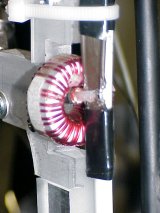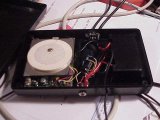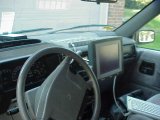W5GGW's QSL Page
My complete web site is here....
APRS from remote locations via PCSat
The Naval midshipmen (middies) have lofted an APRS satellite, PCSAT,
into the orbit that provides remote APRS access. For more
information see Bob
Bruninga's PCSAT web page that has the specifics and latest
information.
Orbit time information can be reached via the Heavens-Above
web page. For Tulsa OK, you can use this
link to go directly to Tulsa relative satellite information.
This web site has links to schedules and orbit information for any of
the
published orbiting objects.
PCSAT was an auxilliary payload on the Kodiak Star mission which
has a total of 3 amateur satellites on board. The Sapphire satellite
also
has Naval Academy Involvment
in a joint venture with Washington University. Starshine is the primary
NASA payload. The following frequencies will be used:
NOTE: PCSAT seems to have drifted
up
in frequency due to the cold temperatures of space. So, the first
half of the approach to peak altitude, please add 5Khz to these
frequencies
to see if that gives you better reception of packets, especially at
9600
baud.
-
145.825 1200 baud PCsat downlink (TLM and, after users enabled,
QRP and HT's only)
-
145.825 9600 baud PCsat downlink (TLM and, after users enabled,
Mobiles)
-
144.39 1200 baud PCsat downlink over USA for brief PCsat posit
and
Telemetry
-
145.825 9600 baud Starshine downlink (Telemetry 1 packet per 2
minutes)
-
437.100 1200 baud Sapphire downlink (and Voice synthesizer)
The International Space Station has
2-Meter Radios!
The ISS has Amateur radio equipment on it for 2-Meter voice and packet
operation. The ISS is easily reachable on a 2-Meter HT with a
simple
whip antenna and around 5 watts. There are just a couple of
important
considerations. You will need a good line of sight to the ISS,
and
that means that it needs to be at least 12-15 degrees above the
horizon.
A ground-plane vertical will also work since it does not limit vertical
radiation.
The important thing is that a J-Pole or other "disk pattern"
antenna
that gets gain by limiting vertical transmission will NOT work.
You can find out where the ISS will be on a day by day schedule by
looking
at the Heavens-Above web
page.
For Tulsa OK, you can use this
link to go directly to Tulsa relative satellite information.
This web site has links to schedules and orbit information for any of
the
published orbiting objects.
You can find out when each pass will be, and how high above the horizon
the object will be etc. Check it out!
APRS Station on ISS Contact Information
The APRS station in the ISS has a TNC that has been reset to factory
defaults.
So, it has its call set to NOCALL. To use it as a digipeater you
should use NOCALL as your path.
UNPROTO CQ VIA NOCALL
The above will configure your TNC to utilize the ISS station as a
digipeater.
Look at the frequency chart below for information
on what frequencies are used for which modes.
At some point, the TNC might become reconfigured with the correct
call
and the battery replaced (the battery apparently failed and caused the
config to be lost). If that occurs, the station is supposed to
have
the call RZ3DZR-1 assigned to it. But, we'll just have to see
what
the final configuration is over time.
Amatuer Radio and the International Space
Station
The SAREX (Space Amateur Radio
Experiment)
program was started in 1983 and made it possible for amatuers to
communicate
with spacecraft. This program is now continuing on as ARISS
(Amatuer
Radio on the International Space Station). Make sure you read up
on the ARISS School
Application
Form which will allow you to schedule time to share the Amatuer
radio
experience and communications with the ISS with students in a school
such
as one of the local schools.
Other good sources of ISS information is
available
at
The ISS schedules are going to be out on the web links above.
The current frequencies are as
follows:
| Voice Down from ISS |
145.800mhz |
| Voice up from ISS in Region 2 & 3 |
144.490mhz |
| Voice up to ISS in Region 1 |
145.200mhz |
| Packet up to ISS |
145.990mhz |
APRS Stuff
I have a rollup J-Pole antenna on a fiberglass
bicycle
flag. Here's a picture of the feed point on the antenna.
The
story is here.

I took the Rand McNally GPS out of the case and put
it
into another case so that I could power it with 12v in the car.
This
is also allows me to put it in my
bike bag
with the radio.

I have an I-Opener in my van that I am using
as a portable APRS platform. I am putting together some Java
based
APRS software that will provide a portable APRS platform for all Java
capable
platforms. I hope to get something out to the world to look at
within
the next month or so...

[email protected]